Histone lysine methyltransferase SMYD3 promotes oral squamous cell carcinoma tumorigenesis via H3K4me3-mediated HMGA2 transcription
- PMID: 37237385
- PMCID: PMC10223939
- DOI: 10.1186/s13148-023-01506-9
Histone lysine methyltransferase SMYD3 promotes oral squamous cell carcinoma tumorigenesis via H3K4me3-mediated HMGA2 transcription
Abstract
Background: Epigenetic dysregulation is essential to the tumorigenesis of oral squamous cell carcinoma (OSCC). SET and MYND domain-containing protein 3 (SMYD3), a histone lysine methyltransferase, is implicated in gene transcription regulation and tumor development. However, the roles of SMYD3 in OSCC initiation are not fully understood. The present study investigated the biological functions and mechanisms involved in the SMYD3-mediated tumorigenesis of OSCC utilizing bioinformatic approaches and validation assays with the aim of informing the development of targeted therapies for OSCC.
Results: 429 chromatin regulators were screened by a machine learning approach and aberrant expression of SMYD3 was found to be closely associated with OSCC formation and poor prognosis. Data profiling of single-cell and tissue demonstrated that upregulated SMYD3 significantly correlated with aggressive clinicopathological features of OSCC. Alterations in copy number and DNA methylation patterns may contribute to SMYD3 overexpression. Functional experimental results suggested that SMYD3 enhanced cancer cell stemness and proliferation in vitro and tumor growth in vivo. SMYD3 was observed to bind to the High Mobility Group AT-Hook 2 (HMGA2) promoter and elevated tri-methylation of histone H3 lysine 4 at the corresponding site was responsible for transactivating HMGA2. SMYD3 also was positively linked to HMGA2 expression in OSCC samples. Furthermore, treatment with the SMYD3 chemical inhibitor BCI-121 exerted anti-tumor effects.
Conclusions: Histone methyltransferase activity and transcription-potentiating function of SMYD3 were found to be essential for tumorigenesis and the SMYD3-HMGA2 is a potential therapeutic target in OSCC.
Keywords: Epigenetics; HMGA2; Oral squamous cell carcinoma; SMYD3; Tumorigenesis.
© 2023. The Author(s).
Conflict of interest statement
The authors declare no conflict of interest.
Figures
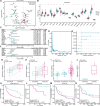
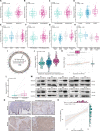
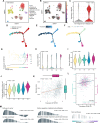
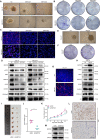
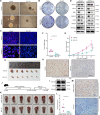
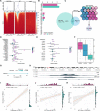
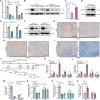

Similar articles
-
SMYD3 stimulates EZR and LOXL2 transcription to enhance proliferation, migration, and invasion in esophageal squamous cell carcinoma.Hum Pathol. 2016 Jun;52:153-63. doi: 10.1016/j.humpath.2016.01.012. Epub 2016 Feb 5. Hum Pathol. 2016. PMID: 26980013
-
SMYD3 regulates the abnormal proliferation of non-small-cell lung cancer cells via the H3K4me3/ANO1 axis.J Biosci. 2022;47:53. J Biosci. 2022. PMID: 36222132
-
SMYD3 promotes hepatocellular carcinoma progression by methylating S1PR1 promoters.Cell Death Dis. 2021 Jul 23;12(8):731. doi: 10.1038/s41419-021-04009-8. Cell Death Dis. 2021. PMID: 34301921 Free PMC article.
-
SMYD3: a regulator of epigenetic and signaling pathways in cancer.Clin Epigenetics. 2021 Feb 26;13(1):45. doi: 10.1186/s13148-021-01021-9. Clin Epigenetics. 2021. PMID: 33637115 Free PMC article. Review.
-
Smyd3-associated regulatory pathways in cancer.Semin Cancer Biol. 2017 Feb;42:70-80. doi: 10.1016/j.semcancer.2016.08.008. Epub 2016 Aug 21. Semin Cancer Biol. 2017. PMID: 27554136 Review.
Cited by
-
USP15 Facilitates Colorectal Cancer Immune Evasion through SMYD3/CCL2-Dependent Myeloid-Derived Suppressor Cell Recruitment.Cancer Immunol Res. 2025 Aug 1;13(8):1226-1245. doi: 10.1158/2326-6066.CIR-24-1194. Cancer Immunol Res. 2025. PMID: 40323348 Free PMC article.
-
SMYD family in cancer: epigenetic regulation and molecular mechanisms of cancer proliferation, metastasis, and drug resistance.Exp Mol Med. 2024 Nov;56(11):2325-2336. doi: 10.1038/s12276-024-01326-8. Epub 2024 Nov 1. Exp Mol Med. 2024. PMID: 39482529 Free PMC article. Review.
-
Molecular Mechanisms in the Carcinogenesis of Oral Squamous Cell Carcinoma: A Literature Review.Biomolecules. 2025 Apr 25;15(5):621. doi: 10.3390/biom15050621. Biomolecules. 2025. PMID: 40427514 Free PMC article. Review.
-
H3K4me3 regulates the transcription of RSPO3 in dermal papilla cells to influence hair follicle morphogenesis and development.Epigenetics Chromatin. 2025 Aug 8;18(1):52. doi: 10.1186/s13072-025-00611-8. Epigenetics Chromatin. 2025. PMID: 40775776 Free PMC article.
-
Potential of melatonin to reverse epigenetic aberrations in oral cancer: new findings.EXCLI J. 2023 Dec 12;22:1280-1310. doi: 10.17179/excli2023-6624. eCollection 2023. EXCLI J. 2023. PMID: 38234969 Free PMC article. Review.
References
-
- Yang Z, Yan G, Zheng L, Gu W, Liu F, Chen W, et al. YKT6, as a potential predictor of prognosis and immunotherapy response for oral squamous cell carcinoma, is related to cell invasion, metastasis, and CD8+ T cell infiltration. Oncoimmunology. 2021;10:1938890. doi: 10.1080/2162402X.2021.1938890. - DOI - PMC - PubMed
Publication types
MeSH terms
Substances
LinkOut - more resources
Full Text Sources
Medical

